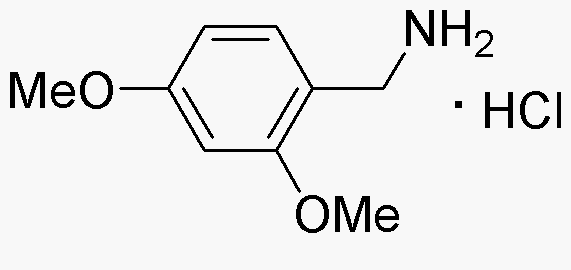2,4-Dimethoxybenzylamine hydrochloride is widely utilized in research focused on:
- Pharmaceutical Development: This compound serves as a key intermediate in the synthesis of various pharmaceuticals, particularly in the development of medications targeting neurological disorders.
- Neuroscience Research: It is used in studies investigating neurotransmitter systems, helping researchers understand the mechanisms underlying mood disorders and cognitive functions.
- Analytical Chemistry: The compound is employed as a reagent in chromatographic techniques, aiding in the analysis of complex mixtures in drug formulation and quality control.
- Organic Synthesis: It acts as a building block in organic synthesis, facilitating the creation of more complex molecules for use in various chemical applications.
- Biochemical Studies: Researchers utilize it to explore enzyme interactions and metabolic pathways, contributing to advancements in biochemistry and molecular biology.
General Information
Properties
Safety and Regulations
Applications
2,4-Dimethoxybenzylamine hydrochloride is widely utilized in research focused on:
- Pharmaceutical Development: This compound serves as a key intermediate in the synthesis of various pharmaceuticals, particularly in the development of medications targeting neurological disorders.
- Neuroscience Research: It is used in studies investigating neurotransmitter systems, helping researchers understand the mechanisms underlying mood disorders and cognitive functions.
- Analytical Chemistry: The compound is employed as a reagent in chromatographic techniques, aiding in the analysis of complex mixtures in drug formulation and quality control.
- Organic Synthesis: It acts as a building block in organic synthesis, facilitating the creation of more complex molecules for use in various chemical applications.
- Biochemical Studies: Researchers utilize it to explore enzyme interactions and metabolic pathways, contributing to advancements in biochemistry and molecular biology.
Documents
Safety Data Sheets (SDS)
The SDS provides comprehensive safety information on handling, storage, and disposal of the product.
Product Specification (PS)
The PS provides a comprehensive breakdown of the product’s properties, including chemical composition, physical state, purity, and storage requirements. It also details acceptable quality ranges and the product's intended applications.
Certificates of Analysis (COA)
Search for Certificates of Analysis (COA) by entering the products Lot Number. Lot and Batch Numbers can be found on a product’s label following the words ‘Lot’ or ‘Batch’.
*Catalog Number
*Lot Number
Certificates Of Origin (COO)
This COO confirms the country where the product was manufactured, and also details the materials and components used in it and whether it is derived from natural, synthetic, or other specific sources. This certificate may be required for customs, trade, and regulatory compliance.
*Catalog Number
*Lot Number
Safety Data Sheets (SDS)
The SDS provides comprehensive safety information on handling, storage, and disposal of the product.
DownloadProduct Specification (PS)
The PS provides a comprehensive breakdown of the product’s properties, including chemical composition, physical state, purity, and storage requirements. It also details acceptable quality ranges and the product's intended applications.
DownloadCertificates of Analysis (COA)
Search for Certificates of Analysis (COA) by entering the products Lot Number. Lot and Batch Numbers can be found on a product’s label following the words ‘Lot’ or ‘Batch’.
*Catalog Number
*Lot Number
Certificates Of Origin (COO)
This COO confirms the country where the product was manufactured, and also details the materials and components used in it and whether it is derived from natural, synthetic, or other specific sources. This certificate may be required for customs, trade, and regulatory compliance.


